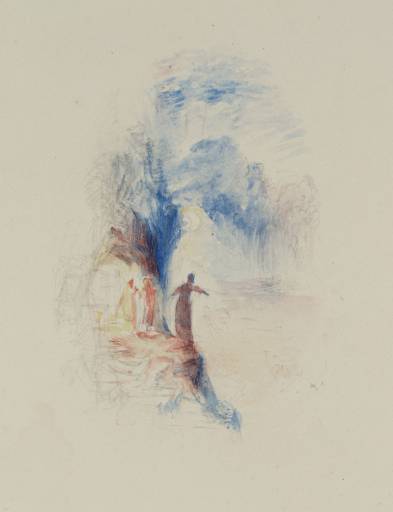This sketch belongs to a large group of preliminary studies which relate to Turner’s vignette illustrations for John Macrone’s 1839 edition of Thomas Moore’s The Epicurean, a Tale: and Alciphron, a Poem. The work appears to be an experimental study for Moore’s fantastical prose tale, The Epicurean and Jan Piggott has identified the subject as the grotto of the Christian anchoret (hermit), a kindly soul who converts and marries the hero, Alciphron, to his love, the former pagan priestess, Alethe. Turner illustrates the moment where the hermit ushers Alciphron to a cave where he can find shelter, and the lovers are temporarily parted:
The full light of day had now risen upon the desert, and our host, reminded, by the faint looks of Alethe, of the many anxious hours we had passed without sleep, proposed that we should seek, in the chambers of the rock, such rest as a hermit’s dwelling could offer. Pointing to one of the largest of these openings, as he addressed me, – “Thou wilt find”, he said, “in that grotto a bed ...” ... There was a sadness in the countenance of Alethe, as I took leave of her, to which the forebodings of my own heart but too faithfully responded; not could I help fearing, as her hand parted lingeringly from mine, that I had, by this sacrifice, placed her beyond my reach for ever ... Having lighted for me a lamp ... the holy man led me to the entrance of the grotto ... I then, with a desponding spirit, hurried into the cavern.
(Thomas Moore, The Epicurean, 1839, pp.166–7)
Despite the schematic nature of the work, Turner effectively captures the mood of Moore’s writing. The tall, shadowy figure of the hermit, the graceful poise of Alethe as she bids a tender, reluctant farewell to Alciphron, and the mouth of the cave illuminated by the rich glow from the lantern inject a sense of poignant romance to this little scene. However, like many of Turner’s studies for The Epicurean, the subject was not selected for publication. Moore may have objected to the artist’s departure from the facts of the text; in the story, the episode takes place at noon, not at night.

